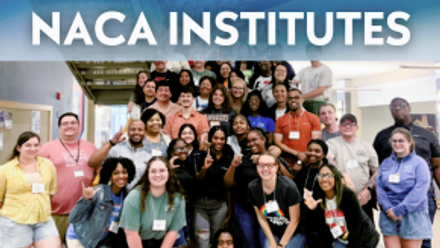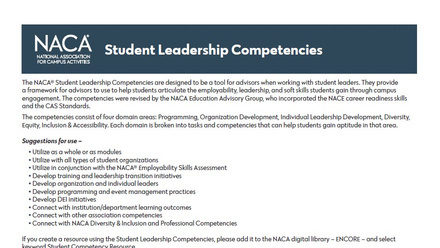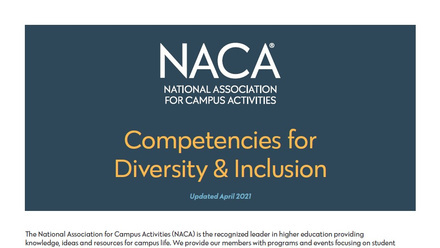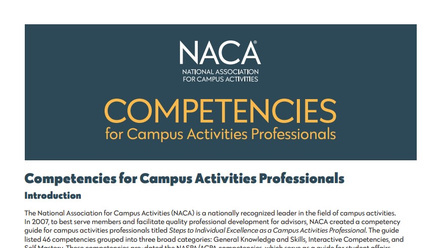Creating a Sense of Belonging through Well-being
Student affairs has long been in the business of holistic student development. However, as we emerge from the pandemic into a new normal and there is more and more emphasis on mental health, student health and well-being emerges as a focus of that holistic development. A study conducted in 2019 by the American Council on Education found that 80% of college presidents deemed mental health a higher priority and 72% had found additional funding or reallocated funds toward mental health initiatives (Busta, 2019). An international survey conducted by the Chronicle of Higher Education and Salesforce.org in 2021 showed that 76% of students struggle with maintaining their well-being. The return to campuses laid bare the gaps in services and lack of funding and resources. Staffing on campuses remains an issue as well, as student affairs departments have trouble filling vacant positions and while staff struggle with their own issues. The same 2021 study showed that 73% of faculty and staff also struggle to maintain wellness (Salesforce.org). Campuses need to be creative and find tools that can help them support their students, staff, faculty, and community.
One of the tools that is available to campuses is the Okanagan Charter. The Okanagan Charter: An International Charter for Health Promoting University and Colleges, “calls on post-secondary schools to embed health into all aspects of campus culture and to lead health promotion action and collaboration locally and globally. Created in June 2015, the Charter provides institutions with a common language, principles, and framework to become health and well-being promoting campuses.” The Charter calls for schools to imbue health into all areas across campus – from operations to academics (HealthyPromotingCampuses.org) – and into the communities surrounding them.
The Okanagan Charter emphasizes a comprehensive and systemic approach to creating a healthy campus culture. Too often, colleges and universities take a deficit approach that focuses on perceived deficits students bring with them to campus, rather than focus on the systems (whether on- or off-campus) that these students exist within. Campuses also take a departmental, or siloed, approach to issues, allowing many on campuses to feel that well-being is not their concern.
The Charter seeks to “create campus cultures of compassion, well-being, equity and social justice,” provides an action framework for higher education, and has two main calls to action.
Call to Action 1: Embed health into all aspects of campus culture, across the administration, operations and academic mandates.
1.1: Embed health in all campus policies.
1.2: Create supportive campus environments.
1.3: Generate thriving communities and a culture of well-being.
1.4: Support personal development.
1.5: Create or re-orient campus services.
Call to Action 2: Lead health promotion action and collaboration locally and globally.
2.1: Integrate health, well-being and sustainability in multiple disciplines to develop change agents.
2.2: Advance research, teaching and training for health promotion knowledge and action.
2.3: Lead and partner towards local and global action for health promotion.
(Okanagan Charter, 2015)
What does the approach to these actions look like? It includes addressing existing policies and systems that create barriers to student success and well-being and ensuring that solutions are comprehensive and campus wide. It includes engaging people with lived experiences (including students, community members, etc.) who are impacted by the policy, and/or system and working across departments. Fragmented, siloed approaches that are typical on college campuses will not work.
Campuses can choose to join the U.S. Health Promoting Campuses Network (USHPCN) whether or not they choose to adopt the Okanagan Charter. Every campus is eligible to become a health promoting campus, regardless of size, classification, affiliation, etc. “The ultimate goal of the Network is to guide and support campuses, as they navigate the process to adopt the Okanagan Charter as an aspirational document to guide their campus well-being efforts from a comprehensive and systems level approach. The USHPCN is a support network that helps campuses define, develop strategies, and create metrics for what it means to be a health promoting campus, as it will be different for each campus, based on their unique circumstances, resources, and needs” (U.S. Health Promoting Campuses Network, 2022). Network schools may then self-select into a cohort process of formally adopting the charter. Currently, eight US schools have joined officially adopted the Okanagan Charter and 104 schools are in the USHPCN.
College communities may also choose to employ the Inter-Association Definition of Well-being into their work. This definition was a result of collaboration among higher education professional associations who signed on to the Health and Well-being in Higher Education: A Commitment to Student Success statement (Health and Well-being in Higher Education, 2019). They offered both a simple definition – “we define well-being as an optimal and dynamic state that allows people to achieve their full potential” - and expanded definition of well-being. The expanded definition focuses on both individual well-being and community well-being. “By focusing on the whole – the whole person, the whole educational experience, the whole institution, the whole community – well-being becomes a multifaceted foal and a shared responsibility for the entire institution” (NIRSA, et al, 2020, p.2).
According to a recent white paper, institutions are streamlining offices under the auspices of well-being. These offices may include campus recreation, counseling, health services, drug and alcohol prevention, and sexual health. Student organizations, club sports, and recreation are being connected to learning outcomes that are anchored in well-being (Gruenke and Wilson, 2022). Student affairs professionals will need to be equipped to work with these different areas and find ways to incorporate overall student well-being into their everyday practice.
Tools like the Okanagan Charter, the U.S. Health Promoting Campuses Network, and the Inter-Association Definition of Well-being can help college communities create a sense of belonging. Sense of belonging is defined by the Association as the extent to which individuals feel their authentic self is personally accepted, respected, included, supported, and safe in the university environment. A sense of belonging plays a part in a student’s overall well-being. These tools help colleges and universities take a holistic approach to the development of students. Improved well-being means an improved sense of belonging, increased retention, and overall student success, helping to create college communities where everyone belongs.






